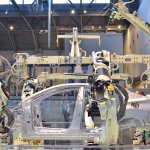Global AI spend set to double by 2023, says IDC

The next four years could see companies double their spend on artificial intelligence (AI) as real-world applications of the technology gather pace. Automated customer service agents, threat intelligence and prevention systems, and sales process recommendation and automation will dominate spend.
That’s based on a report by the International Data Corporation (IDC) that states that spend on AI solutions will reach US$97.7 billion in 2023, more than double that of the US$37.5 billion estimated in 2019. The figure would represent a compound annual growth rate of 28.4 percent over the period.
David Schubmehl, the research director at IDC in charge of Cognitive/Artificial Intelligence systems said; “The use of artificial intelligence and machine learning (ML) is occurring in a wide range of solutions and applications from ERP and manufacturing software to content management, collaboration, and user productivity.
“Artificial intelligence and machine learning are top of mind for most organizations today, and IDC expects that AI will be the disrupting influence changing entire industries over the next decade.”
AI is finding its way into major industries
Banking and retail sectors will lead the shift to AI. According to the report, each of these industries will invest more than US$5 billion in 2019. In the retail sector, nearly half of the spending on technology will go towards automated customer service agents, expert shopping advisors, and product recommendation systems.
On the other hand, the banking industry is set to ramp up spend on automated threat intelligence and prevention system, as well as fraud analysis and investigation system.
Significant investments would also be made in discrete manufacturing, process manufacturing, healthcare, and professional services. The fastest industries to grow in terms of spending would be the media industry and governments with a five-year CAGR of 33.7 percent and 33.6 percent respectively.
According to Marianne D’Aquila, Research Manager at IDC Customer Insight & Analysis, said: “Strategic decision-makers across all industries are now grappling with the question of how to effectively proceed with their AI journey.
“Some have been more successful than others, as evidenced by banking, retail, manufacturing, healthcare, and professional services firms making up more than half of the AI spend.
“Despite the learning curve, IDC sees higher than average five-year annual compounded growth in government, media, telecommunications, and personal and consumer services,” D’Aquila said.
YOU MIGHT LIKE

How Haribo Sweets is mastering the data-led supply chain
A wide range of use cases would drive AI investments. The largest— automated customer service agents, threat intelligence and prevention systems, along with sales process recommendation and automation— will deliver 25 percent of all spending in 2019.
The use cases that will see the fastest spending growth over the 2018-2023 forecast period are automated human resources (43.3 percent CAGR) and pharmaceutical research and development (36.7 percent CAGR).
The vast projected spend will be led by AI’s limitless use cases across a range of industries— companies are swiftly adopting the technology in order to gain a competitive advantage, through enhanced efficiency and customer service.
The ramped-up spend will accompany the advent of 5G technology, which will show its potential in business in the new years. This enhanced connectivity will facilitate the collection of massive volumes of data— via IoT sensor networks, for example. AI will play a crucial role in processing and driving action from this data in real-time.
At the same time, further developments in AI will see the technology become more powerful and more accessible to all types of businesses, with varying budgets.
Unsurprisingly— in the race to become the global tech superpower— the US and China will be the biggest spenders throughout the forecast period.









